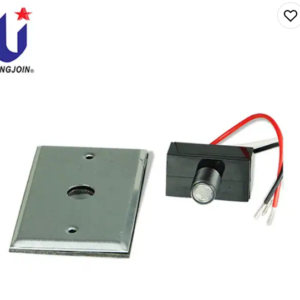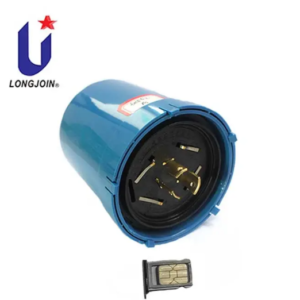Dusk to Dawn Photocell Sensor led Bulb Holder (E26/E27)
Product Details:
Dusk to Dawn Photocell Sensor led Bulb Holder (E26/E27)




Product features
The photoelectric switch JL-301 is applicable to control the street lighting, passage lighting and doorway lighting automatically in accordance with the ambient lighting level.
Schematic Diagram

More Details
| -Polycarbonate / PPS Enclosure |
| -CDS Sensor (JL-301/302/303) |
| -Nickel Plated Brass |
Principle of the E26/E27 Photocell Sensor
The E26/E27 Photocell Sensor is a light-sensitive switch designed for use in the lamp base of standard screw-in bulbs. The principle of operation is based on a Light Dependent Resistor (LDR) or other similar light-sensitive element. When there is sufficient ambient light, the resistance of the LDR becomes smaller, causing the current in the circuit to increase or reach a certain preset threshold, which triggers a switching action that typically breaks the circuit and turns off the connected fixture. Conversely, when the ambient light becomes dim or below a certain set light level, the resistance of the photoresistor increases and the current in the circuit decreases, which is not enough to trigger a switching action, so the circuit remains closed, allowing current to pass through and keeping the fixture on.
In addition, some advanced light controllers may also integrate timers, dimmers, or other intelligent features to meet more complex lighting needs.
Market Feedback
E26/E27 head style light controls have received widespread adoption and positive feedback in the market. Below are some common market feedback points:
- Energy saving and environmental protection: the light controller can automatically adjust the switch of the lamps and lanterns according to the ambient light, thus avoiding unnecessary power waste and helping to save energy and reduce emissions.
- Convenient and easy to use: Easy to install and use, automatic lighting control can be realized without manual intervention.
- Extend the life of lamps: By reducing unnecessary running time of lamps, the life of lamps can be extended.
- Improve safety: Automatically turning on the lamps and lanterns in low-light conditions helps to improve safety at night or in dimly lit environments.
- Intelligent trend: with the development of smart home technology, the light controller is also becoming more and more intelligent, and can be linked with cell phone APP, smart speakers and other devices to realize richer functions.
Customers may encounter the following major problems when using E26/E27 lamp head type light controller:
- Improper sensitivity settings:
The sensitivity of the light controller may be set too high or too low, resulting in triggering the switch action when it is not needed, or failing to turn on the fixture in time when it is needed.
For example, if the sensitivity is set too high during the day when it is cloudy or late in the evening, the light controller may misjudge it to be night and turn on the fixtures early. - Installation Location Problems:
If the light controller is installed in an incorrect location, it may be interfered with by the surrounding environment, resulting in it not working properly.
For example, if installed near a window or other light source, the light controller may not be able to properly turn off the fixture at night because it is receiving too much light. - Compatibility issues with other devices:
Customers may encounter compatibility issues if they try to use the light controller with other smart devices (e.g., smart speakers, smart switches, etc.).
These issues may include failure to pair correctly, failure to synchronize statuses, or failure to perform scheduled scenes. - Power issues:
The optical controller may not work properly due to power issues, such as unstable voltage or loose power plugs.
These problems may result in the light controller not being able to read light levels correctly or perform switching actions. - Equipment malfunction:
As an electronic device, the photocontroller may malfunction or become damaged.
For example, the photosensitive element may lose sensitivity due to aging or damage, causing the light controller to not function properly. - Lack of user manual or support:
If customers are not provided with a detailed user manual or technical support, they may experience difficulties in using the device.
For example, they may not know how to properly set the sensitivity, install the location, or pair it with other devices.
Certification


| 1. Your inquiry related to our products or prices will be replied in 24hrs. |
| 2. Well-trained and experienced staffs to answer all your enquires in fluent English. |
| 3. OEM&ODM, any your customized photo controls we can help you to design and put into product. |
| 4.Our market researches help you to analyse your market before offering you the competitive price and suitable quality. |
| 5. We confirm with you about all details before we proceed the production, Professional QC will keep the whole production in eyes; Quality inspection and loading are performed in every order. |
| 6. We keep track of your selling. We improve our products and service by listening to the comments from you. We are trying to be your life-partner. |

|
Q1: What is the function of the photo control? A1: Photo control is one kind of switch that turn on and off the lighting fixture automatically according to the lighting level’s change. |
|
Q2: What is the Warranty for the Photo control? A2: For the photo control, we have half a year warranty. If any quality problems on our side occurred in this period ,we will take on the shipping cost and replacement. |
|
Q3: What is the Specification of wires? A3:Main wire of receptacle: 14 AWG signal wire:18 AWG |
|
Q4: What is the methods of installation of this type photo control? A4 ANSI C136.41 compliant dimming receptacle is available with two or four dimming contacts to support either 0-10 VDC dimming methods or Digital Addressable Lighting Interface. |
|
Q5:What is the type of the photo control? A5: According to different internal control modes, the photocontrol products can be divided into three types which are thermal type, electromagnetic type and electronic type. |
|
Q6: What is the international standard of your photo control? A6:Our photo control receptacle could be divided into British and American types and be manufactured as per BS5972 or ANSI C136.10 standard. |
| Q7: Which kinds of the lamps can the photo control be used for?
A7: It can be worked smoothly at anytime, any place and any season, and suitable for street lamp, garden lamp, corridor lamp, door lamp., etc .
|










